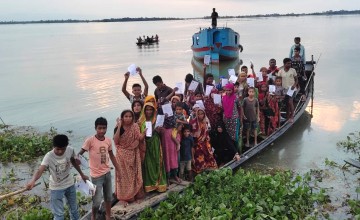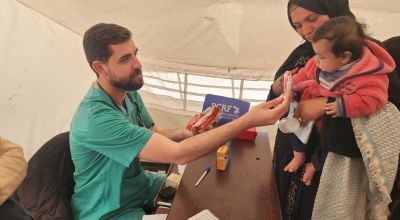
Knowledge Hub
Floods are putting millions of lives at risk in Bangladesh as water levels continue to rise after over a month of heavy rainfall.
The flooding began on 17 May 2022 in two districts of the Sylhet region of Bangladesh when torrential rain caused rivers to overflow. Since then, heavy monsoon rains and water have inundated and submerged more areas, leaving millions of people marooned and triggering a humanitarian crisis. The devastation has now expanded across nine districts, causing widespread displacement and destruction of infrastructure and property, as well as injuries, illness and death.
More than 7 million people have been impacted so far.

How people are impacted
Hundreds of thousands of homes are underwater. About 94% of Bangladesh's Sunamganj town and 84% of the surrounding Sylhet district are now submerged. Roads leading to the region have been largely cut off, and there are power cuts even in areas not underwater.
Bangladesh has about 700 rivers, making it particularly vulnerable to flooding during extreme weather events. The flash floods swept away homes and inundated farmlands, forcing families to seek shelter on higher ground and temporary flood shelters. The safety and security of women and girls in these shelters are at high risk.
As of 20 June, 2492 cases of diseases and injuries have been recorded. This includes diarrhoea, skin, respiratory and eye infections, as well as near drowning. There is also a possibility of additional disease outbreaks as the water recedes.
Seven million people in Bangladesh are in desperate need of shelter and aid.

How Concern is responding
Along with our partners, we have reached out to the affected remote areas, all the while working closely with local government and district government authorities.
Our emergency response is focusing initially on providing 5,000 households with:
- Dried food packages;
- Water purification tablets;
- Hygiene kits.
We are also providing additional non-food items; the repair and maintenance of wells for water, sanitation and hygiene purposes; cash grants, and multipurpose cash grants targeting people with disabilities.
Working with local partners, we are going to extend our support in a big scale for flood response and recovery as the situation continues to deteriorate.

Other ways to help
Donate now
Give a one-off, or a monthly, donation today.
Join an event
From mountain trekking to marathon running, join us for one of our many exciting outdoor events!
Buy a gift
With an extensive range of alternative gifts, we have something to suit everybody.
Leave a gift in your will
Leave the world a better place with a life-changing legacy.
Become a corporate supporter
We partner with a range of organisations that share our passion and the results have been fantastic.
Create your own fundraising event
Raise money for Concern by organising your own charity fundraising event.




